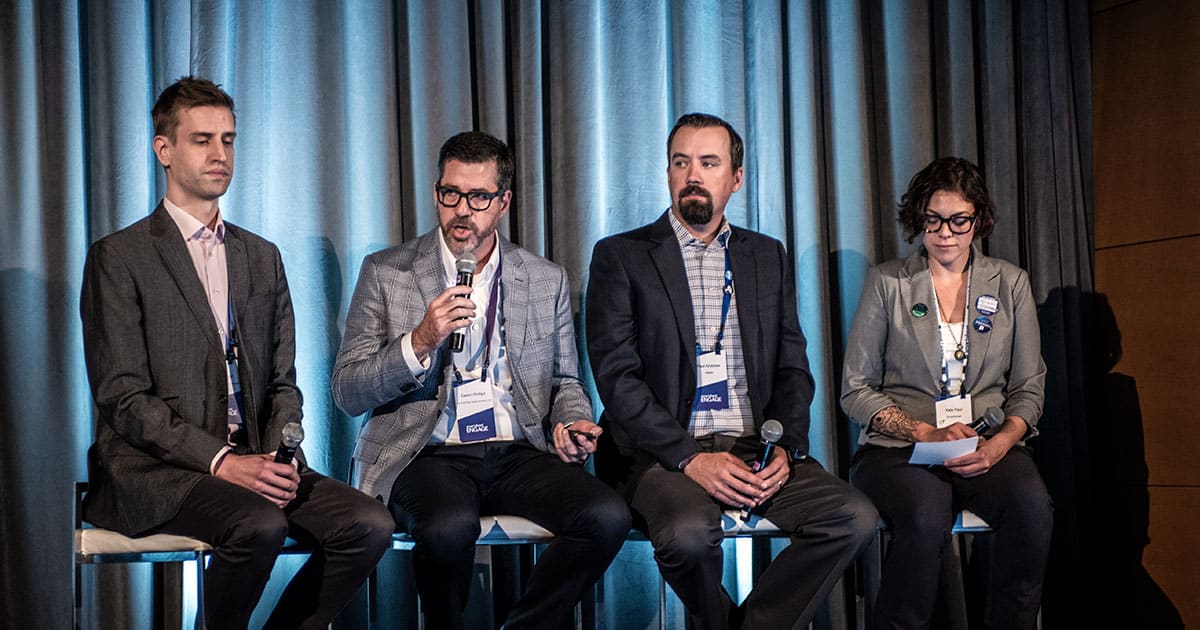In the construction industry, property owners, architects, and contractors need to work together to build new and renovate existing structures. Many companies still use paper-based systems to manage contracts, permits, blueprints, and other required documents, or use disconnected software tools to track each phase of the construction project life cycle. However, some innovative companies are moving beyond paper and fully embracing digital transformation.
During an ENGAGE’18 panel, three leaders in the construction industry shared how they use the Smartsheet work execution platform to improve field operations, organizational efficiency, and quality control.
These impressive representatives from Kiewit, Top Shelf Real Estate Advisors, and Chipman Design Architecture spoke about their experiences with adopting Smartsheet to better surface and efficiently communicate important information, such as budget health and timelines, to their stakeholders and customers in real time.
Top Shelf Real Estate Advisors Saves Time, Gains Transparency
As a small business, Top Shelf Real Estate Advisors uses Smartsheet Control Center to power their entire company. From meeting notes to potential change order (PCO) logs, they have a consistent record of approvals, estimates, and more to share with property owners.
Since rolling out Smartsheet dashboards to monitor their projects, Top Shelf Real Estate Advisors has gained real-time transparency, which is one of the company’s core values, with stakeholders and clients.
“We’ve reduced weekly project calls by 50 percent, just by going off [our dashboard] and keeping everybody in line.”
Darrin Phillips
Founder & CEO
Top Shelf Real Estate Advisors, LLC
In addition, they’ve increased budget accuracy, reduced data entry, and reduced material delivery and damage delays by 50 percent by removing multiple versions of important documents.
Kiewit Pays Vendors Faster With Forms
Kiewit, a 130-year-old construction company that touches many market segments — including power, transportation, mining, and building — has one of the largest, privately-owned fleets in North America.
Kiewit's number one priority is to keep their employees safe. Prior to adopting Smartsheet, they maintained a binder system for referencing safety manuals and best practices. While chock full of important information, it wasn’t readily available to workers in the field.
Using Smartsheet, they built a sheet for all KBM Safety Reference Manuals, so workers can access the latest versions from their smartphones. This cuts down on worker trips to the office, increases focus on work tasks, and most importantly, promotes safe work practices across all work sites.
Before Smartsheet, the team at Kiewit relied on spreadsheets and a paper ticketing system, which created many inefficiencies. Drivers in the field had to return to the office with their tickets, which often got lost between the site visit and headquarters. Some employees even stored dozens of these small tickets in their desks, causing delays in payment.
By using Smartsheet for desktop and mobile, the accounts payable team receives immediate updates from the field, from quantity tracking to cost accruals.
“We went out and created a [Smartsheet] form. Now when a truck comes in, they can fill out the information on the form, take a picture of it, and their job is done.”
Paul Andrews
District Controller
Kiewit Bridge and Marine
Their accounts payable team then takes the form submissions and updates their master sheet right away, so vendors get paid faster for their services.
Chipman Design Architecture Scales Processes, Delights Clients
The role of the architect is to produce as tightly coordinated and deliberately detailed set of permitting, bidding, and construction documents to minimize the issues found in the field that can lead to lost revenue.
Prior to adopting Smartsheet, Chipman Design Architecture had no org-wide master schedule and no way to track process improvements, other than financial profit and loss. They developed a goal between attending ENGAGE’17 and ENGAGE’18, working to leverage the Smartsheet platform’s power of scale and to promote widespread visibility across multiple accounts and teams. At the project level, they’re able to highlight client-issued deadlines, and the format and frequency of those dates.
At the organizational level, they surface key metrics on Smartsheet dashboards using Microsoft Power BI, tailoring them based on stakeholder type. At some level, every team member touches the Smartsheet platform.
“Building a structure of shared vocabulary, so that you can spread insights, and the success and challenge or the oversight with an individual or a team to the entire organization — that’s the key and why there is such opportunity [using] Smartsheet.”
Kyle Chipman
Process Manager
Chipman Design Architecture
To gain more insights on how these construction leaders innovate with Smartsheet, including a roundtable discussion and an open Q&A segment, watch the session video below:


